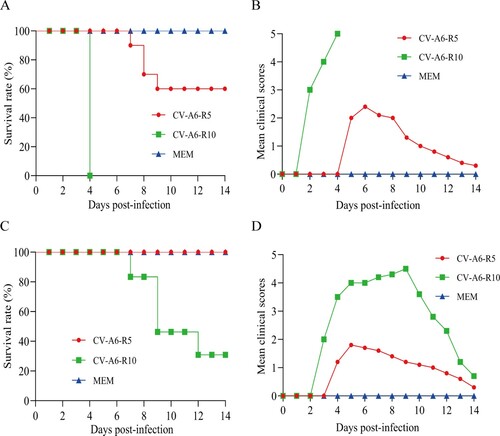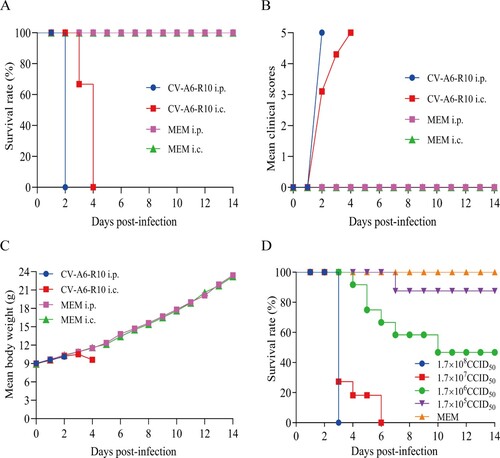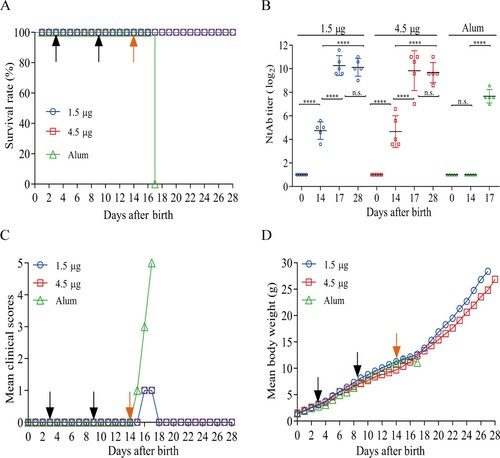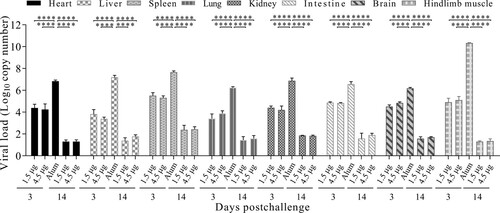Figures & data
Figure 1. Virulence of CV-A6 in Kunming mice. Five-day-old (upper panels, 7.6 × 104 CCID50/mouse) and ten-day-old (bottom panels, 1.1 × 105 CCID50/mouse) Kunming mice (n = 10) were i.c. inoculated with CV-A6-R5 or CV-A6-R10. Control animals were inoculated with MEM medium. Survival rate (A and C) and mean clinical scores (B and D) were monitored and recorded daily after infection.

Figure 2. Determination of the optimal infection route and establishment of the Kunming mouse model. Twelve-day-old mice (n = 6) were i.p. and i.c. inoculated with CV-A6-R10 at doses of 1.7 × 108 CCID50/mouse and 1.7 × 107 CCID50/mouse, respectively. Control animals were inoculated with MEM medium. All the mice were monitored daily for survival rate (A), mean clinical scores (B) and mean body weight (C) until 14 days post-infection (dpi). The LD50 of CV-A6-R10 was determined through the i.p. route at the doses indicated (D).

Figure 3. Efficacy of the vaccine in mice immunized with the two vaccine formulations. Immunization was performed in groups of 14-day-old Kunming mice (n = 10) via i.p. route. High and low doses (4.5 μg and 1.5 μg/mouse) of the inactivated vaccine candidate were inoculated with adjuvants Alum. Control group were inoculated with Alum-only. Kunming mice were primed and boosted on days 3 and 9 and challenged on day 14 at a dose of 35 LD50 (3.46 × 107 CCID50/mouse). Bleeding was performed on days 0, 14, 17 and 28. Black and orange arrowheads indicated the date of vaccination and challenge, respectively. The inoculated mice were monitored for survival rate (A), mean clinical scores (C) and mean body weight (D) for a period of 14 days. (B) NtAb titers of serum of mice vaccinated with vaccines or Alum-only (n = 5) were determined and presented as the geometric mean titer (GMT) ± the standard error of the mean (SEM). NtAb titers below 8 were assigned to 2 for convenience of figure presentation. Each symbol represented a mouse, and the solid line indicated the GMT of the group. The data were analyzed with one-way ANOVA. **** and n.s. indicating P < 0.0001 and no significant difference (P ≥ 0.05), respectively.

Figure 4. Virus distributions in various organs of immunized-challenged Kunming mice. Kunming mice immunized with 1.5 μg, 4.5 μg vaccines or Alum-only were i.p. inoculated with 35 LD50 (3.46 × 107 CCID50/mouse) of CV-A6-R10. The graph showed the virus loads in the heart, liver, spleen, lung, kidney, intestine, brain and hindlimb muscle tissues at 3 dpi or 14 dpi. Virus loads were assessed by qRT-PCR and compared with standard curves obtained from 10-fold serial dilutions of CV-A6 transcript. The data represent the mean ± SEM for five mice per group and were analyzed with one-way ANOVA (****, P < 0.0001).

Figure 5. Histopathologic and IHC analyses of tissues from immunized-challenged Kunming mice. Histological (A) and IHC (B) of various tissues from immunized-challenged Kunming mice were analyzed. Immunized Kunming mice were i.p. inoculated with a lethal dose (3.46 × 107 CCID50/mouse) of CV-A6-R10. The Alum-only groups were euthanized immediately following death on 3 dpi, and mice in the vaccinated groups were euthanized at 3 dpi and 14 dpi. Sections from lung, muscle, brain and heart tissues were stained with hematoxylin to detect pathological changes. Viral proteins were detected in IHC assays with an anti-CV-A6 whole virus polyclonal antibody as the primary antibody. Original magnification, × 200. Images shown are representative of two Kunming mice in each group. Black arrowheads indicated representative inflammatory cell infiltration (A) and expression of viral antigen (B).

Figure 6. Expression of inflammatory cytokines in serum from immunized-challenged Kunming mice. Immunized (vaccine or Alum-only) mice were i.p. inoculated with a lethal dose (3.46 × 107 CCID50/mouse) of CV-A6-R10. The levels of IL-4 (A), IL-6 (B), TNF-α (C) and IFN-γ (D) in the serum of Kunming mice were determined with individual mouse ELISA detection kits at 3 dpi. Data represent the mean results of three experiments ± SEM and were analyzed with one-way ANOVA (****, P < 0.0001; ***, P < 0.001). NC, PBS-inoculated negative control.

